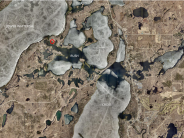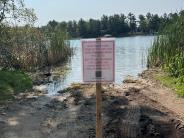STARRY STONEWORT CONFIRMED IN RUSH LAKE
The Minnesota Department of Natural Resources has confirmed the presence of the invasive algae starry stonewort in Rush Lake near Crosslake in Crow Wing County.
Rush Lake is part of the Lower Whitefish Chain of Lakes. Starry stonewort had not previously been confirmed in the Whitefish Chain of Lakes.
A contractor working on Rush Lake contacted the DNR after finding suspected starry stonewort. The contractor was hired by the Whitefish Area Property Owners Association to conduct plant surveys at boat accesses within the Whitefish Chain of Lakes. A DNR invasive species specialist confirmed the presence of starry stonewort at the Rush Lake public water access, which is located on a channel between Rush Lake and Whitefish Lake.
Follow-up surveys are being conducted to determine starry stonewort distribution in Rush Lake and to determine whether starry stonewort is present in other lakes in the Lower Whitefish Chain of Lakes. The DNR is working with the Whitefish Area Property Owners Association and Crow Wing County to determine immediate response steps.
Starry stonewort is usually identified by the star-shaped white bulbils for which it is named. These bulbils typically become visible in late summer.
Starry stonewort has now been confirmed in 31 water bodies in Minnesota. It was first confirmed in Minnesota in 2015.
Starry stonewort is an algae that looks like some native aquatic plants. Information on how to identify starry stonewort can be found on the DNR website.
Starry stonewort can form dense mats, which can interfere with recreational uses of a lake and compete with native plants. It is most likely spread when fragments have not been properly cleaned from trailered boats, personal watercraft, docks, boat lifts, anchors or other water-related equipment.
Starry stonewort has never been eradicated from any U.S. lake or river, but treatment or careful removal can help reduce the risk of spread and relieve associated nuisance impacts on water-related recreational activities. Early detection is key to effective management.
Whether or not a lake has any invasive species, Minnesota law requires people to:
- Clean watercraft, trailers and equipment to remove aquatic plants and prohibited invasive species.
- Drain all water and leave drain plugs out during transport.
- Dispose of unwanted bait in the trash.
- Never release bait, plants or aquarium pets into Minnesota waters.
- Dry docks, lifts and rafts for 21 days before moving them from one water body to another.
These additional steps reduce the risk of spreading aquatic invasive species:
- Decontaminate watercraft and equipment – find free stations on the courtesy decontamination page of the DNR website.
- Spray watercraft and equipment with high-pressure water or rinse with water if high-pressure water is not available.
- Dry watercraft and equipment for at least five days before using in another water body.
People should contact a Minnesota DNR aquatic invasive species specialist if they think they have found starry stonewort or any other invasive species that was not already known to be in the water body.
More information is available on the aquatic invasive species page of the DNR website at mndnr.gov/ais .
Dispatch staff report, "Starry stonewort confirmed in Rush Lake in Crow Wing County" Brainerd Dispatch, 9 September 2024, https://brainerddispatch.com/news/local/starry-stonewort-confirmed-in-ru...
THE WORKING PUBLIC ACCESS LOCATED OFF OF GINSENG PATCH ROAD IS CLOSED UNTIL FURTHER NOTICE.



